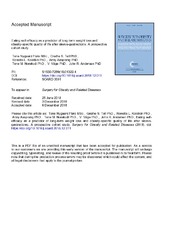| dc.contributor.author | Flølo, Tone Nygaard | en_US |
| dc.contributor.author | Kolotkin, Ronette L. | en_US |
| dc.contributor.author | Aasprang, Anny | en_US |
| dc.contributor.author | Norekvål, Tone M. | en_US |
| dc.contributor.author | Våge, Villy | en_US |
| dc.contributor.author | Andersen, John Roger | en_US |
| dc.contributor.author | Tell, Grethe S. | en_US |
| dc.date.accessioned | 2019-05-31T11:33:48Z | |
| dc.date.available | 2019-05-31T11:33:48Z | |
| dc.date.issued | 2019-02 | |
| dc.Published | Flølo TN, Kolotkin RL, Aasprang A, Norekvål TM, Våge V, Andersen JR. Eating self-efficacy as predictor of long-term weight loss and obesity-specific quality of life after sleeve gastrectomy: A prospective cohort study. Surgery for Obesity and Related Diseases. 2019;15(2):161-167 | eng |
| dc.identifier.issn | 1550-7289 | |
| dc.identifier.issn | 1878-7533 | |
| dc.identifier.uri | https://hdl.handle.net/1956/19827 | |
| dc.description.abstract | Background: A person's confidence to control eating, eating self-efficacy (ESE), has been identified as a target for long-term weight management in nonsurgical weight loss interventions, but has to a limited extent been studied after bariatric surgery. Objective: We investigated the association between ESE, weight loss, and obesity-specific quality of life (QOL) after sleeve gastrectomy (SG). Setting: A single-center longitudinal study. Methods: Data from adult patients were collected before SG, and at mean 16 months (±standard deviation 4 mo) and 55 (±4) months postoperatively. ESE was measured by the Weight Efficacy Lifestyle Questionnaire Short-Form. Multiple regression analyses were performed with excess body mass index loss (%EBMIL) and obesity-specific QOL as dependent variables. Age, sex, and other preoperative values were covariates in all models. Results: Of 114 preoperative patients, 91 (80%) and 84 (74%) were available for follow-up 16 and 55 months after SG, respectively. Mean %EBMIL from baseline to 16 and 55 months was 76% (95% confidence interval: 71.9, 79.6) and 67% (95% confidence interval: 61.9, 72.2), respectively. Preoperative ESE scores improved significantly at both 16 and 55 months (P = .002) but did not predict postoperative %EBMIL or QOL at 55 months (β = −.08, P = .485). Greater change in ESE from 0 to 16 months predicted higher %EBMIL (β = .34, P = .013) at 55 months, and improvements in ESE from 0 to 55 months were significantly associated with higher %EBMIL (β = .46, P = .001) and obesity-specific QOL (β = .50, P < .001) 55 months after SG. Conclusion: Significant improvements in ESE were seen at 16 months, and remained high at 55 months after SG in this cohort. Patients who improved their ESE the most also experienced the highest weight loss and obesity-specific QOL 5 years postoperatively. Future research should address whether enhancement of ESE corresponds to sustained improvements in eating behavior after bariatric surgery. | en_US |
| dc.language.iso | eng | eng |
| dc.publisher | Elsevier | eng |
| dc.rights | Attribution CC BY-NC-ND | eng |
| dc.rights.uri | http://creativecommons.org/licenses/by-nc-nd/4.0/ | eng |
| dc.subject | Bariatric surgery | eng |
| dc.subject | Sleeve gastrectomy | eng |
| dc.subject | Eating self-efficacy | eng |
| dc.subject | Obesity-specific quality of life | eng |
| dc.title | Eating self-efficacy as predictor of long-term weight loss and obesity-specific quality of life after sleeve gastrectomy: A prospective cohort study | en_US |
| dc.type | Peer reviewed | |
| dc.type | Journal article | |
| dc.date.updated | 2019-01-29T07:35:48Z | |
| dc.description.version | acceptedVersion | en_US |
| dc.rights.holder | Copyright 2018 Elsevier | |
| dc.identifier.doi | https://doi.org/10.1016/j.soard.2018.12.011 | |
| dc.identifier.cristin | 1667022 | |
| dc.source.journal | Surgery for Obesity and Related Diseases | |
| dc.source.pagenumber | 161-167 | |
| dc.identifier.citation | Surgery for Obesity and Related Diseases. 2019;15(2):161-167 | |
| dc.source.volume | 15 | |
| dc.source.issue | 2 | |

